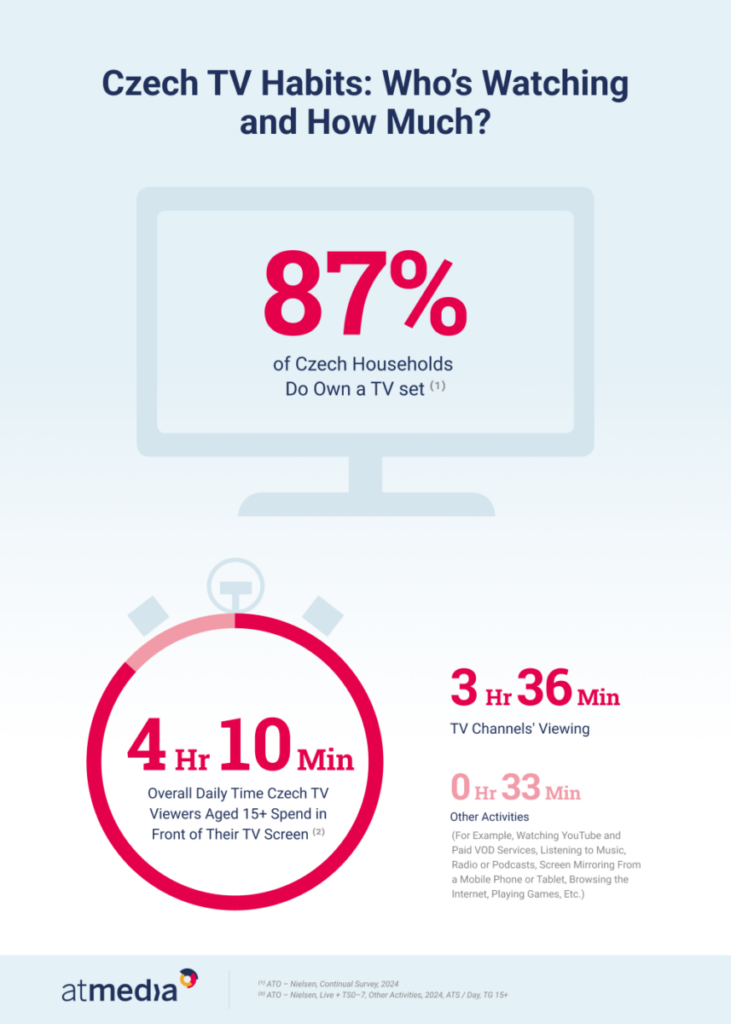With the advent of internet connectivity, the television has firmly established itself as the multimedia hub of the modern home. Although streaming services, YouTube and gaming are all on the rise, traditional TV viewing remains the leading activity on the big screen across all age groups – as confirmed by as by the official audience measurement data interpreted by Atmedia, the sales house for thematic TV channels on the Czech market.
In 2024, Czech viewers aged 15 and over spent an average of 4 hours and 10 minutes per day in front of their television screens. ‘TV viewing does continue to be the main use of the largest screen in the home,’ points up Michaela Suráková, Atmedia’s Managing Director. According to official audience measurement data, watching traditional TV channels accounts for 87% of total television screen time – equivalent to 3 hours and 36 minutes per day. The remaining 13% (33 minutes) is spent on the so-called other activities, such as watching YouTube or paid VOD services, listening to music, radio or podcasts, mirroring content from a mobile phone or tablet, browsing the internet, or gaming.[1] A television set is present in 87% of Czech households – nearly nine out of ten homes.[2]
TV Channel Viewing Still Prevalent Even Among Younger Audiences
In recent years, the use of TV sets for non-traditional activities has been increasing steadily across all age groups. Among viewers aged 15+, time spent on such activities has grown by 53% compared to 2020 – equating to an additional 12 minutes per day. The rise is even more marked within certain demographics, with a 74% increase among 25–34-year-olds and an 85% increase among those aged 35–44.[3]
It is younger viewers who spend the most time on non-TV content activities. For instance, those aged 25–34 do spend an average of 54 minutes per day on such activities – accounting for 34% of their total TV screen time. Nevertheless, traditional TV channels continue to account for the majority of their viewing time – an average of 1 hour and 44 minutes per day. A comparable trend is observed among the 35–44-year-olds, who spend a daily average of 2 hours and 20 minutes watching TV channels (73%), while 53 minutes (27%) are allocated to other forms of screen use.[4]
The older the audience, the greater the share of time spent watching traditional television channels. Among those aged 45–54, non-TV activities account for 15% of their total screen time, in the 55+ group, this drops to just 6%.[5] ‘Even though younger viewers do use their TVs for more than just watching programmes, they still spend most of their screen time by watching traditional TV channels,’ notes Michaela Suráková. ‘It would be therefore wrong to suggest that young people no longer watch television – they still do, though to a lesser extent than in the past.’
57% of TV Households Now Own an Internet-Connected TV
The growing use of television sets for non-traditional activities is closely tied to technological development – particularly the rising number of internet-connected TVs. While in 2020 only 35% of TV households had an internet-enabled television, by last year that figure had risen to 57%.[6] ‘Thanks to internet connectivity, the television has evolved into a true multimedia device. Today’s viewers can not only switch between dozens of TV channels but also access paid VoD services and stream content on YouTube,’ says Michaela Suráková. She also points out that, even with all these new options, watching traditional TV channels is still the main activity for all age groups.
[1] ATO – Nielsen, Live + TS0–7, Other Activities, 2024, ATS / Day, TG 15+
[2] ATO – Nielsen, Continual Survey, 2024
[3] ATO – Nielsen, Live + TS0–7, Other Activities, 2020 & 2024, ATS / Day, TG 15+, 25–34, 35–44
[4] ATO – Nielsen, Live + TS0–7, Other Activities, 2024, ATS / Day, TG 25–34, 35–44
[5] ATO – Nielsen, Live + TS0–7, Other Activities, 2024, ATS / Day, TG 45–54, 55+
[6] ATO – Nielsen, Continual Survey, 2020, 2024



